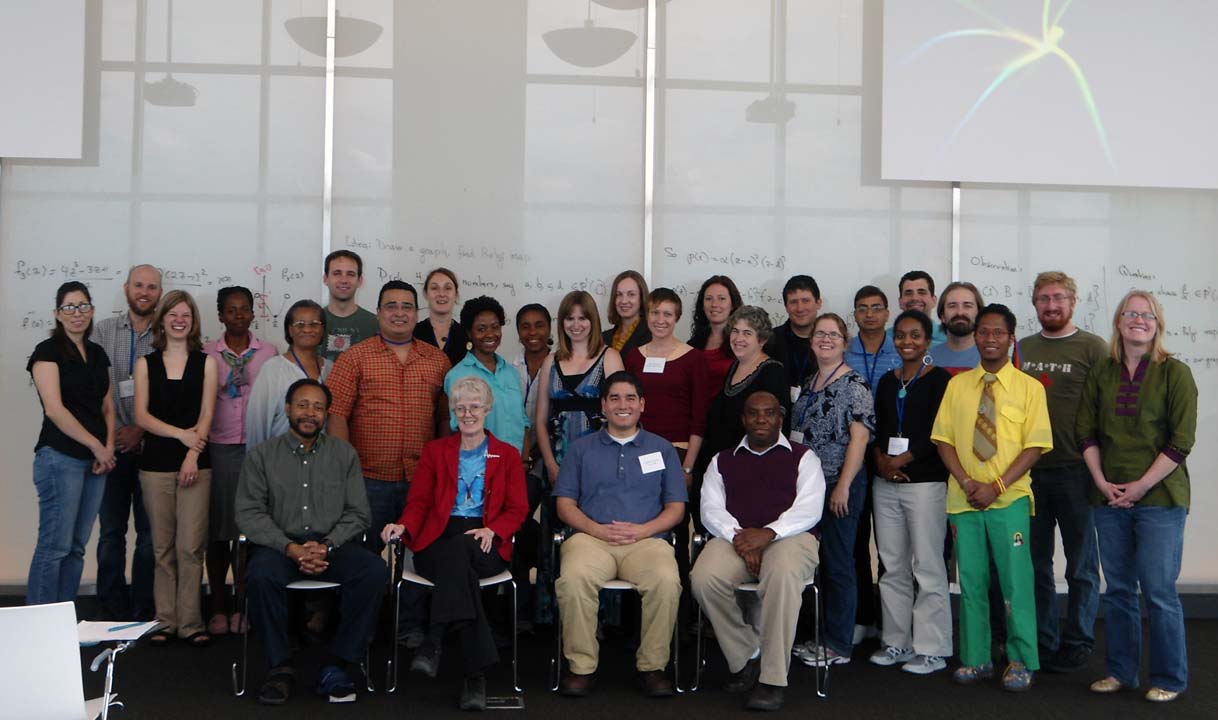Research Experiences for Undergraduate Faculty (REUF4@ICERM)
List of Participants in REUF4 more photos
Stephan's comments on undergraduate research
Trends in Undergraduate Research in the Mathematical Sciences conference in Chicago, October 26 - 28, 2012
all REUF website (requires login)
SAGE
ISU Sage server (you will need a preset account that you get from Leslie at the workshop to use this)
Sage.org server (you can create an account here)
KAIST Groundhog Day Sage server (you can create an account here, resets every day)
Download Sage (you made need help to do this)
Quick reference to Sage
Sage online documentation and tutorial
1. Minimum rank, maximum nullity, zero forcing (Matrices and Graphs)
Slides related to Leslie's talk
Terminology
vector space, subspace, matrix, matrices and linear maps,matrix
arithmetic, elementary row operations, (reduced) row echelon form, transpose, symmetric, nonsingular = invertible
matrix, similar matrices, span, linear independence, basis, dimension, rank, range,
kernel, column space, row space, determinant, properties and elementary methods of
computation of determinant, eigenvalue, eigenvector, characteristic polynomial,
spectrum, spectral radius,
algebraic and geometric multiplicity of an eigenvalue.
Graph (simple, undirected) - note that the
definition of a graph depends on the book so the first think you need to do with any
book is figure out what is meant by "graph."
Subgraph, induced subgraph, path, cycle,
complete graph, connected graph, connected component, graph isomorphism, planar graph,
tree, adjacency matrix.
References
Any standard undergraduate linear algebra book should be fine, but
it is easier to read matrix oriented ones,
such as:
Howard Anton, Elementary Linear Algebra, John Wiley
David C. Lay, Linear
Algebra and Its Applications, Addison Wesley
Steven .J. Leon, Linear Algebra with
Applications, Prentice Hall.
The basic graph terms can be found in any elementary graph theory book or
combinatorics book that has a chapter on graph theory.
For example,
Richard Brualdi, Introduction to Combinatorics, Prentice Hall. In the 5th edition the
relevant subsection is 11.1. Here is a PDF version of that chapter.
2. Prime and co-prime labeling of graphs (Graph theory)
Nate's slides
Terminology
Graph (simple, undirected) - note that the
definition of a graph depends on the book so the first think you need to do with any
book is figure out what is meant by "graph."
Subgraph, induced subgraph, path, cycle,
complete graph, connected graph, connected component, graph isomorphism, planar graph,
tree, adjacency matrix.
References
The basic terms can be found in any elementary graph theory book or
combinatorics book that has a chapter on graph theory.
For example,
Richard Brualdi, Introduction to Combinatorics, Prentice Hall. In the 5th edition the
relevant subsection is 11.1. Here is a PDF version of that chapter.
For more detailed information, just look up the terms in the index
of any of these books:
Schaum's Outline of Graph Theory: Including Hundreds of Solved Problems
(Paperback) by V. Balakrishnan
Introductory Graph Theory by Gary Chartrand
Pearls in Graph Theory: A Comprehensive Introduction by Nora Hartsfield and
Gerhard Ringel
3. Dessins d'enfants (Algebra, Graphs, Geometry)
Edray's slides
Terminology
Alternating Group, Symmetric Group, Bipartite Graph, Path Graph, Platonic Solid, Chebyshev Polynomial, Mobius Transformation
References
This short article gives an overview of Dessins d'Enfants but may
be difficult to read carefully before the workshop- it may be fun to
skim it: Notices Amer. Math. Soc. 2003 Zapponi.pdf
If you get hooked by Dessins d'enfants and want to know more, here is background that will be used in the project: background.pdf
4. Fractionally dense sets (Analysis and Diophantine Equations)
Terminology
This project is
designed to be accessible to a variety of students from various
backgrounds. The basic questions can be understood by a solid
calculus student, while more advanced questions can be addressed by
more sophisticated students and faculty. For the basics, we
require only knowledge of real numbers, rational numbers, and limits.
Knowledge of other topics (e.g., prime numbers, Fibonacci numbers,
matrices, countable sets, complex numbers, etc.) can be used to develop
other problems.
References
The basics of the real
number system and limits can be found in many calculus books or
introductory analysis texts. A useful blend of calculus and
number theory at the undergraduate level is: Shahriari; "Approximately
Calculus"
Some basic familiarity with elementary number theory may be useful, but
is not strictly necessary. Some possible references (in
increasing order of sophistication) are:
Pommersheim, Marks & Flapan; "Number Theory: A Lively Introduction with
Proofs, Applications, and Stories"
Burton; "Elementary Number Theory"
Niven, Zuckerman & Montgomery; "An Introduction to the Theory of Numbers"
Hardy & Wright; "An Introduction to the Theory of Numbers"
Questions or comments to hogben@aimath.org or brianna@aimath.org

